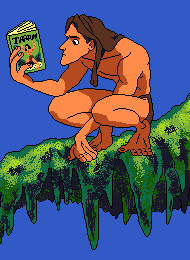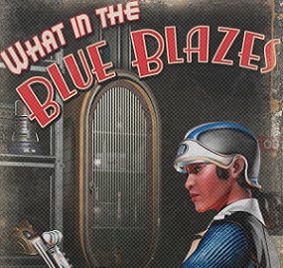| ITEM |
ERB |
DISNEY |
OUR OPINION |
CONCLUSION |
| The date |
According to Tarzan authorities, approximately the year 1908. |
During the reign of Queen Victoria, which ended in 1901. |
Even though it is inaccurate, the Victorian era lends a particular charm to the characters. It helps that it's our favorite historical age. |
This date would give us trouble if the entire life of Tarzan were to be explored, but it works for a one-shot film. |
| Click here for more on the date of Tarzan. |
|
|
|
|
| Tarzan: appearance |
Grey eyes; a cross between a Greek statue & a 40's leading man |
Blue eyes; attractive, but not classically handsome |
Grey eyes wouldn't translate well in animation, & the look works for a jungle king just starting out on his adulthood. |
The most important thing about any Tarzan project is Tarzan. If he's not right, you're wasting your time. Disney's Tarzan has a great look. So far, so good. |
| Tarzan: dialogue |
Once he learns English, Tarzan speaks it as well as anyone. |
With the apes, Tarzan is articulate. With humans, he learns as the film progresses. |
Past movies created a monosyllabic Tarzan entirely foreign to the books, giving Tarzan an innocent, child-like quality. |
The Disney Tarzan is right on the money here. |
| Tarzan: yell |
No one knows exactly how the victory cry of the bull ape should sound. |
Disney did a variation on the old movie version. |
The Tarzan yell is so strongly associated with the character in the minds of the public that a similar yell was necessary. |
A very satisfying yell. |
| Tarzan: hair |
To keep it out of his eyes, Tarzan cuts his hair (crudely) with his father's hunting knife. |
Tarzan sports unkempt dreadlocks. |
This hair style gives the ape man a grubby look, inappropriate for a hero and leading man. |
Shorter shaggy hair would have been better. |
| Tarzan: facial hair |
He teaches himself to shave with a knife. |
He somehow has not begun to grow a beard yet. |
In the novel, Tarzan learns about men from books and is determined to become one; thus, he shaves to look more human and less simian. The Disney Tarzan is unaware of the existence of humans until he meets the Porter party. Still trying to be an ape, he probably would've enjoyed growing hairier. |
Disney ignores this aspect of coming of age with good reason. A bearded Tarzan would've been disastrous. |
| Tarzan: personality |
Grim, stoic, often savage. |
A kinder, gentler Tarzan. |
The Tarzan of the novels would probably get a PG rating and might not be suitable for younger children. He is a bit too violent to be a good role model. |
Disney can get away with this version of Tarzan since he is so young in the film. |
| Tarzan: education |
Tarzan teaches himself to read by endlessly studying childrens' books. |
Tarzan is taught about humans by Jane with the help of a magic lantern show. |
To translate this scene to film would require lots and lots of explanation and/or narration and would certainly slow things to a crawl. |
Although the Burroughs scene is our personal favorite inthe book, Disney made the right decision here |
| Jane |
American girl, tough enough to survive dozens of dangers, adores her husband. |
English girl, cute & quirky, but not wimpy; she's fun to have around. |
Jane requires a personality to function as more than a mere plot device & focus for Tarzan's affection. |
Disney's Jane is by far the most fascinating version yet. |
| The Apes |
Not true gorillas, they are a previously unknown species of primate; the Great Apes. |
Gorillas in many ways realistic, but with Disneyfied personalities. |
The introduction of a new species of ape would have required an explanation unsuitable for a film. |
An unimportant difference. |
| Kerchak |
Leader of the apes. |
Leader of the apes and Kala's mate (in the book, Tarzan's foster father is Tublat). |
Kerchak takes on the roles of two of the novel's characters. |
When translating books to the screen, it is often advisable to reduce the number of characters in this way. It makes for a tighter story and cuts down on explanation time. |
| Kala |
Kindly she-ape who adopts the infant Tarzan when her own baby dies. |
Ditto. |
Not much is changed here, except that her personality is fleshed out. |
Kala emerges as an interesting and very sympathetic character. |
| Tarzan's parents |
Deliberately marooned by mutineers, they build a cabin in which their son is born. Lady Alice dies in her sleep one year later, and Sir John is killed by Kerchak. |
Shipwrecked in Africa with their infant son, they build a treehouse. They are later killed by a leopard. |
The important change here is to keep Kerchak from becoming a villain. |
The audience wouldn't want Tarzan to be reconciled with Kerchak if the ape was a murderer. |
| Terk |
Although Tarzan has acquaintances and perhaps friends among the apes, none of them is given a specific personality. |
Tarzan's best friend. |
Terk is a pure Disney character, lively and silly, but endearing enough. |
She's pretty cool, and adds comic relief. |
| Tantor |
Tantor is the Mangani word for elephant and does not refer to any specific pachyderm. Tarzan considers elephants his friends. |
A whiny, neurotic young elephant who grows up to be a whiny, neurotic adult. One of Tarzan's few friends. |
Tarzan needed to have a friend or two, or else why would he want to stay in the jungle so badly? |
Although we agree with the purpose of the character, we just can't get to like this wimpy guy, preferring an elephant character with a little more dignity. |
| Clayton |
A member of Professor Porter's party. Not a bad fellow, just terribly ordinary when compared to our Tarzan. He plans to marry Jane. |
Professor Porter's guide, he is later revealed to be a villain with his own agenda. |
Clayton does make a satisfying villain. And it makes sense to involve the apes in the climax by putting them directly in jeopardy from Clayton. We were surprised at the elimination of the Clayton/Jane romance subplot, but it would have distracted from the main theme of Tarzan's quest for identity. |
The original Tarzan of the Apes, although one of the greatest novels ever written, ends with Tarzan unsatifactorily allowing Jane to return to England to marry Clayton. In some ways, the first two novels must be read together to make the story complete. This would not do for a film. |
| Professor Porter |
An absent-minded professor. |
Perhaps less absurd, but cuter than in the book. |
A peripheral character used mainly for comic relief, Disney was right to try to make him as interesting as they could manage. |
He's a hit, especially when he joins the jungle family at the end. |
| Sabor |
The name for a lioness. |
The leopard who fights Tarzan. |
No, no, no! Every tarmangani knows that sabor is a lioness and sheetah is a leopard. |
We still cringe everytime we hear this one. |
| The climax |
The novel is filled with battles with animals and natives and villains, although none is truly climactic. There are several chapters that take place after Tarzan and Jane leave the jungle (separately), dealing with Tarzan's perceptions of the civilized world, Jane's impending marriage, and Tarzan's birthright, which form a sort of an anti-climax. |
The apes are endangered by Clayton, who wants to sell them to a zoo. |
Very exciting, very cinematic, a ripping good battle! |
A satisfying ending in a novel does not always translate to a satisfying ending on screen. Disney wisely chose a more straightforward, less wordy climax. |
| The finale |
After they marry, Tarzan builds Jane a house in the jungle where they can enjoy the best of both worlds. |
Jane goes ape and swings through the trees with the best of them. |
The Jane of the Jungle idea owes more to the previous movies than to the book. |
Oh, well, let it pass. It's not enough to spoil the best Tarzan film ever made. |





![]()

